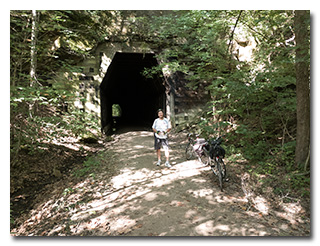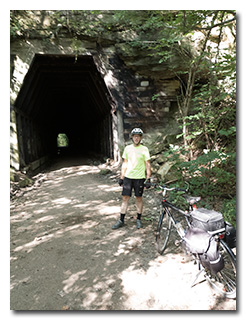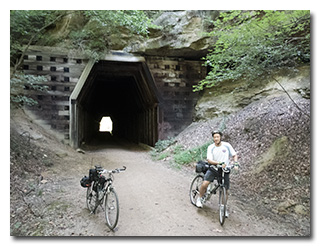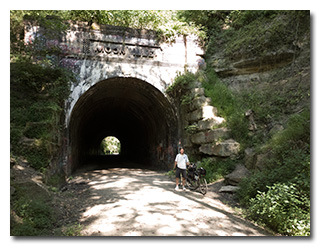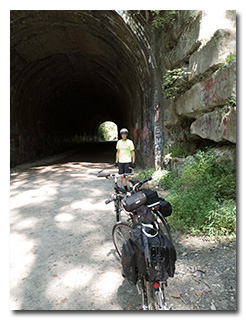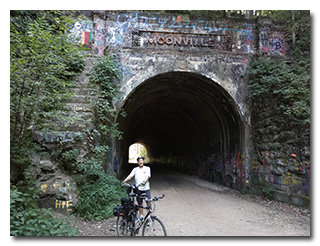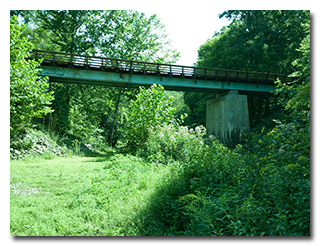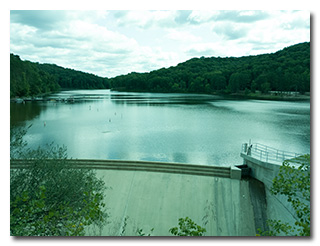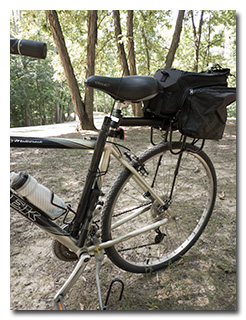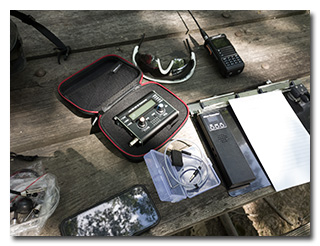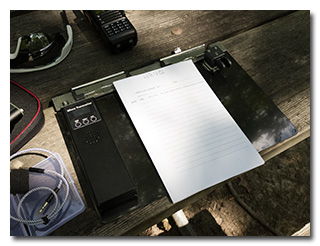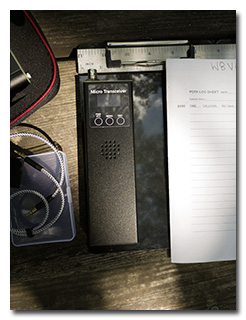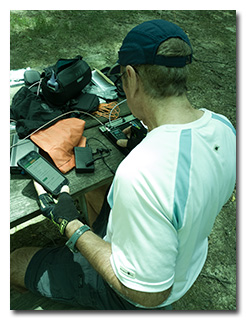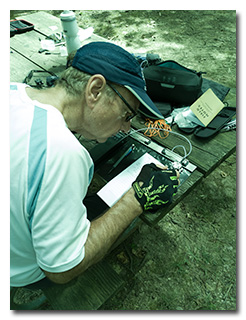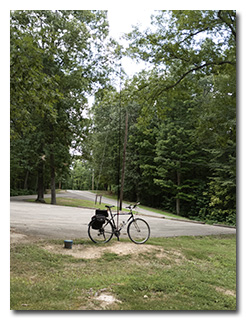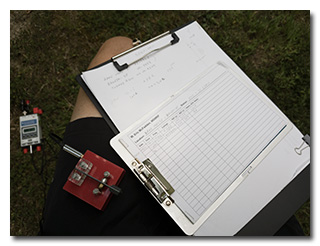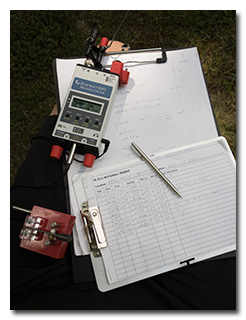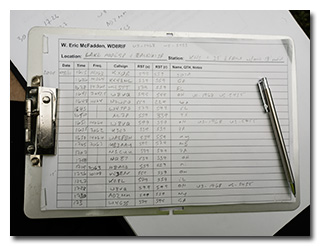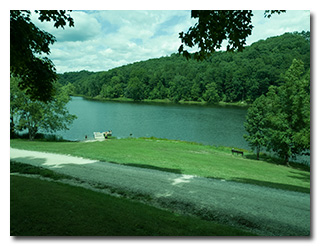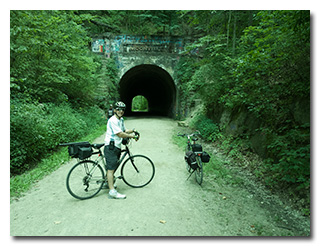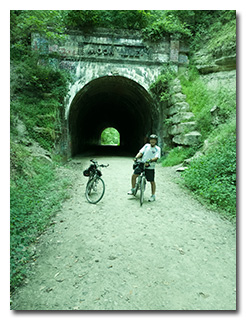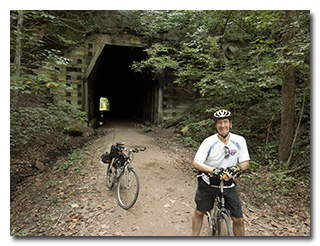- Outbound:
- Len at entrance to King's Hollow Tunnel
- Eric at entrance to King's Hollow Tunnel; photo by Len Touth
- Len at exit from King's Hollow Tunnel
- Len at entrance to Moonville Tunnel
- Eric at entrance to Moonville Tunnel; photo by Len Touth
- Len at exit from Moonville Tunnel
- The former Gallia County SR-160 Raccoon Creek Bridge
- Lake Hope within Lake Hope State Park
- Activation:
- Inbound:

by William Eric McFadden
From the Moonville Rail Trail website:
-
This 10-mile rail trail takes visitors through the beautiful woodlands of southeast Ohio, including Zaleski State Forest; the communities of Zaleski and Mineral; and the Lake Hope State Park wetland areas. The corridor holds water on both sides of the trail, creating a wetland area that is home to numerous species of flora and fauna.
Additional points of interest along this trail are two unique and historic tunnels. King’s Hollow Tunnel (also known as King Switch Tunnel) is a 120-foot structure carved through the rock and lined by a series of 12x12 wooden beams. The Moonville Tunnel is brick-lined and has a long history of train accidents, earning the tunnel a reputation for being haunted.
From the Lake Hope State Park website:
-
Though the roar of the iron furnaces no longer echoes through the hills of Vinton County, there are many reminders of days gone by at Lake Hope State Park. Situated at the northern edge of Ohio's Hanging Rock iron region, the park reflects the rich history of southeastern Ohio's industrial past. Built in 1853-54, the Hope Furnace processed the iron ore extracted from the region’s sandstone bedrock. The iron resulting from the ore smelting process was used to produce many different items including ammunition and cannons for the Union Army during the Civil War. Hundreds of men labored, cutting timber, working the furnace, and driving teams of oxen hauling iron ore to the furnace. Charcoal fires, needed to fuel the furnace, were tended 24 hours a day. So much wood was required for this process that the surrounding hillsides were almost completely stripped of their timber.
At the height of the Hope Furnace’s production, Ohio was one of the nation’s leading producers of iron. As time passed, iron ore was discovered farther west, and Ohio’s reputation as a major iron producer waned. The Hope Furnace shut down in 1874, after only 20 years of operation. By 1900, nearly all the major furnaces in southern Ohio were shut down. Today, the Hope Furnace chimney and some of the foundation are all that remain of the structure. Near the chimney, one may find pieces of slag, the cast-off residue from the smelting process. These pock-marked, glass-like pieces have now become a part of the forest floor.
The forest we now see is one that has grown back in place of the primeval forest that once stood hundreds of years ago. For a time, coal was an important Vinton County export. Many mines tunneled into the hills and large quantities of coal were transported out utilizing ox-drawn coal cars, and later the railroad. Most of the mines were abandoned early in the 20th century. Lake Hope Forest Park was created in 1937 by the Division of Forestry. The lands became Lake Hope State Park in 1949 when the Ohio Department of Natural Resources was created.
From the Zaleski State Forest website:
-
The 27,822-acre Zaleski State Forest is the second largest forest in Ohio's system of state forests.
Zaleski State Forest operates the only state-owned sawmill in Ohio. The mill produces rough sawn lumber for use by Ohio’s state forests and state parks as well as other government agencies.
Historic Moonville Tunnel is located within Zaleski State Forest on the Moonville Rail Trail right-of-way.
Pictures
Description
On Sunday, August 11, 2024, one member of the Southeast Ohio Radio Adventure Team performed a successful bicycle-portable simultaneous activation of Lake Hope State Park (US-1968) and Zaleski State Forest (US-5455) in Ohio as part of the Parks on the Air (POTA; link) program.
Eric McFadden, WD8RIF, was joined by Len Touth, W8VQ, for the bicycle-portable two-fer activation of Lake Hope State Park and Zaleski State Forest.
Eric and Len began their bicycle ride at the Moonville Rail Trail trailhead in Mineral, Ohio at 1406 UTC, when the temperature was about 72°. This was Len's first experience of the Moonville Rail Trail and he enjoyed the smooth gravel, the numerous bridges, and especially King's Hollow Tunnel and Moonville Tunnel. While the Moonville Rail Trail itself is very smooth, the rail trail is still missing two bridges west of Moonville Tunnel, and Eric and Len were forced to detour onto the hilly, rough, badly corrugated, Hope Moonville gravel road for about a mile before rejoining the Moonville Rail Trail. Upon reaching the intersection with Wheelabout Road, the pair left the Moonville Rail Trail and detoured onto Wheelabout Road to Hope Schoolhouse so Len could see the museum and gift shop. (It was at Hope Schoolhouse that they learned from the volunteer that the two missing bridges are expected to be built in 2025.) Leaving Hope Schoolhouse, they rode a short distance on Wheelabout Road, Shea Road, and SR-278 to Park Road 9 and the Lake Hope State Park entrance. After pausing to admire the view of Lake Hope at the overlook, and wanting to be perform their activations where cell-signal might be available, the pair slogged up Park Road 9 to Keeton Cemetery, a location where Eric has previously found cell-signal to be available.
Eric and Len arrived at the Keeton Cemetery area at about 1511 UTC to find that the cemetery parking lot and the picnic table across the road be unoccupied. Len chose to set up his station at the picnic table area, leaving Eric to choose a place in the cemetery parking lot or surrounding greenspace. Eric remained with Len to admire his gear and to watch him set up his station.
Taking a cue from Eric, Len chose to bungie his mast mast vertically on his bicycle and used the mast to support a homebrew end-fed random wire (EFRW) as an inverted-vee. Len used two tiny Chinese radios, a µSDX 15/20/40m CW/SSB/FT8 5w transceiver and a µSDX µSDR handheld form-factor CW/SSB 5w transceiver with built-in battery. To match his non-resonant EFRW antenna, Len used an ATU-10-0A automatic antenna tuner with built-in battery. He logged on a very clever home-brew folding clipboard.
This was the first field outing for both of Len's tiny transceivers and he had some issues. The µSDX worked well on the three bands it covered, but the µSDX µSDR output was only 2w even though in testing in his back yard it had generated 4.5w. Still, despite disturbed solar conditions (A-Index = 6; K-Index = 4) and very poor HF propagation, Len was able to use both rigs and his home-brew antenna to make more than enough QSOs to validate his two-fer activation. (The day after this outing, Len learned that both radios provide transmit coverage of all the HF ham bands, not just the bands listed on the respective ordering pages; see below for URLs.)
Links to Len's gear:
- SOTABeams Carbon 6 mast (SOTABeams)
- QRP 9:1 unun (Amazon)
- NTECHGO 18 Gauge silicone wire (AliExpress)
- µSDX transciever (AliExpress)
- µSDX µSDR transceiver (AliExpress)
- ATU-10-0A automatic antenna tuner (Walmart)
After Len had set up his station and had begun his operation, Eric chose to set up his station about 100 yards away at the Keeton Cemetery in order to minimize any chance of interference between the stations. (This strategy worked—neither operator was bothered by the other except when they were operating on the same band.) Eric's station would be his KH1 Micro Travel Kit plus a modified Goture Red Fox Super Hard 720 carbon-fiber mast and, because he hasn't yet come to terms with the KH1's KHPD1 two-lever paddle, a Whiterook MK-33 single-lever paddle. Eric had brought with him his larger and heavier KX2 Mini Travel Kit, just in case he wasn't able to validate his activation using the KH1 Micro Travel Kit. Spoiler alert: The KH1 Micro Travel Kit worked beautifully and Eric did not need to open his KX2 Mini Travel Kit at all except to get out a roll of electrical tape for Len on the bicycle ride back to their cars.
Eric deployed the KH1 Micro Travel Kit's ad hoc EFRW as a 35' sloper, with the high end supported atop his modified Goture Red Fox Super Hard 720 carbon-fiber mast bungied vertically to his bicycle, placing the 13' counterpoise directly on the ground. Lacking a picnic table or a bench, Eric sat on the lightweight telescoping round stool he brought with him for just such an occasion, and juggled his copy-paper, his log, his KH1, and his key on his lap. (Actually, Eric started operating with his KH1 on his lap then, after he dropped it once, he placed the KH1 on the ground, but later brought it back up to his lap, where it stayed until the end of his activation.) Eric was on the air at 1615 UTC.
As he had expected, Eric had good cell-signal at Keeton Cemetery and he and Len were able to verify that they were both spotted on the POTA Spots website (link) and they could use POTA Spots to identify possible Park-to-Park (P2P) QSOs.
Since they were sitting so far apart, Len and Eric used the VHF/UHF handhelds and a 2m simplex frequency to coordinate band changes and to notify each other of P2P QSO opportunities.
Since Len had chosen to start his activation on 40m, Eric chose to begin his operation on 20m. As soon as he turned on his KH1 and set it to 20m, Eric heard KX0R calling CQ for a SOTA activation. On his first call, at 1615 UTC, Eric was able to work KX0R, and he took this as a sign that, maybe, the bands weren't really in such bad shape. Finding himself a clear frequency to run, Eric began to call "CQ POTA", and was auto-spotted on POTA Spots. His first QSO in this run (and second QSO overall) came at 1626 UTC with KK4BNC in Georgia. (The long period spent calling CQ before this QSO let Eric know that band conditions were, truly, not very good.) Eric's third QSO came at 1628 UTC with W4STT in Florida.
Pausing to hunt for P2P QSO opportunities, at 1641 UTC Eric completed an in-park P2P QSO with W8VQ (Len) on 40m.
Returning to 20m, Eric confirmed the frequency he had been on was still clear, and began calling CQ. His first QSO in this run came at 1643 UTC with N7WPO in Washington. This was followed at 1645 UTC by a QSO with W4TPD in Florida, and at 1650 UTC by a QSO with AC7P in Texas. The next QSO came at 1651 UTC and was a second in-park P2P QSO with W8VQ (Len), this time on 20m.
After receiving a notification via HamAlert, at 1655 UTC Eric risked QRMing Len on 40m by quickly hunting and working K3ES who was performing a two-fer activation of PA 024 State Game Land (US-8725) and North Country Trail National Scenic Trail (US-4239) in Pennsylvania.
Returning to 20m, Eric completed a QSO at 1658 UTC with WA2FBN in New York.
Having successfully validated his activation, Eric told Len that he would cede the relatively productive 20m band to him and he would either hunt or run a frequency on 40m. Having not had much success at all on 40m, Len was pleased to be able to try his station on 20m.
Eric decided to try his station on 40m. Finding himself a clear frequency to run, he began calling "CQ POTA", and was auto-spotted on POTA Spots. His first QSO in this run came at 1705 UTC with KB3AAY in Maryland. This was followed at 1707 UTC by a QSO with N1CUU in Pennsylvania, at 1708 UTC by a QSO with NQ8T in Ohio, and at 1719 UTC by a QSO with N8ACD in Michigan.
Switching to 30m, Eric found a clear frequency, began calling "CQ POTA", and was again auto-spotted on POTA Spots. His first QSO in this run came at 1726 UTC with VE3EAV in Ontario. This was followed at 1727 UTC by a QSO with KR8L in Illinois. At 1728 UTC, W8VQ (Len) called Eric for a third in-park P2P QSO, this time on 30m. Eric's fourth QSO in this run came at 1730 UTC with AD2MM in New York. His final QSO came at 1732 UTC with W4GSS in Georgia.
Having spent longer time operating than he had anticipated due to the poor HF propagation conditions, Eric called his activation finished with nineteen QSOs and four P2P QSOs. All of Eric's QSOs were CW and were made at five watts output.
Before tearing down his station, Eric walked over to see how Len was getting on. Len had made twelve QSOs, mostly by hunting for P2P opportunities, more than the ten QSOs required for a valid activation. Satisfied that Len wouldn't need to make any more in-park P2P QSOs to validate his activation, Eric walked back to his station, packed up his station, and loaded his bicycle for the return ride.
Similarly, Len tore down his station and packed his bicycle, and the pair began their ride back to Mineral.
When all was said and done, Eric was very pleased with the performance of his KH1 Micro Travel Kit. The KH1 transceiver is a dream to operate, the ad hoc 35' EFRW deployed easily on the Goture Red Fox Super Hard 720 carbon-fiber mast and the KH1 could match it easily on all the bands he had tried it on, and the Whiterook MK-33 single-lever paddle worked well as a laptop CW paddle. Eric needed nothing he hadn't packed as part of the KH1 Micro Travel Kit—the mast and paddle excluded, of course. This activation was Eric's second bicycle-portable operation during which he had carried both the KH1 Micro Travel Kit and the KX2 Mini Travel Kit, but he's now confident enough in the smaller one that he will begin carrying the KH1 Micro Travel Kit (plus mast and key) as his primary bicycle-portable station.
It's interesting to note that during the ride back to Mineral, Len commented that he was glad he hadn't suffered a tire-puncture while traversing the very rough gravel on Hope Moonville Road, considering that his tires and tubes were about twenty years old, albeit with low mileage. Eric hadn't even thought to be worried about punctures but, the very next day, he suffered a puncture of his rear tube (a "pinch-flat") while descending a rough gravel road during his regular lunchtime ride.
Eric also submitted his log to the World Wide Flora and Fauna in Amateur Radio (WWFF; link) program for an operation at Lake Hope State Park, KFF-1968.
(return)
